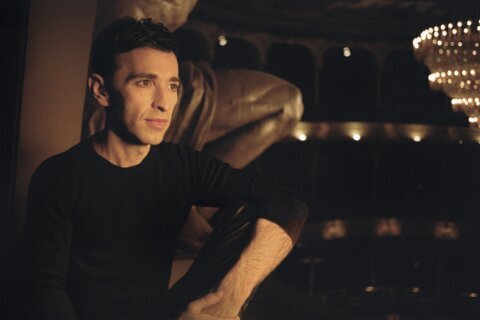It won nine Tony Awards and a Pulitzer Prize in 1976, becoming the longest-running show in Broadway history … until it was surpassed by “Cats” in 1997.
This month, “A Chorus Line” kicks into Signature Theatre through Jan. 5.
“It was just one of those special things that came about in the time when musicals were crashing on Broadway and attendance was at an all-time low,” actor Matthew Risch told WTOP. “[Director] Michael [Bennett] and his friends wanted to create something new and exciting. They were like, ‘No one’s ever talked about the lives of us and what we go through.’ … Combined with the music and choreography, it was a perfect storm of things that became instantly iconic.”
Featuring a book by James Kirkwood Jr. and Nicholas Dante, the story follows theater director Zach (Risch), who auditions 17 dancers for his chorus line.
“It is the process of casting a new Broadway show,” Risch said. “It’s all about the sacrifice and stakes and everything it takes to get into a Broadway show; the sacrifices that artists make for their art and sometimes it can be at a high cost.”
Those risks and rewards are authentic because they’re inspired by real life.
“Michael Bennett and a bunch of his friends who were dancers and artists got together and pressed record on a tape recorder and started talking about the business and what it’s like being in this business,” Risch said. “Very quickly, everyone found out that they started diving deep into their childhoods, their psychological history, their emotional baggage and how it all ties together.”
Why do audiences love self-reflexive shows about show business?
“With other shows like ’42nd Street,’ I think people just love to [go behind the scenes],” Risch said. “It takes a special kind of person to be a performer, to be an actor, and we live in a world that’s obsessed with celebrity. Most people are fascinated by how the other half lives, so I think it’s really fascinating to see the process, the ‘behind the curtain,’ if you will, of what it takes to put on a show.”
The role of Zach is usually a faceless, booming voice from the back of the theater calling out directions to the stage over the loud speakers. Signature Theatre’s production is very different, where Zach is sitting directly among the audience.
“They may be seated right next to me, hopefully unwrapping their candies quietly,” Risch said. “It’s always been this booming voice from the back. … So it’s nice to have this intimate space … being a little more intimate with the director, while maintaining this authority over the cast. That’s been the fun challenge: How do we keep this tension alive while he’s sitting feet away from these performers?”
Don’t worry, all your other favorite elements remain.
“‘A Chorus Line’ is so specific in how it is,” Risch said. “It’s kind of a perfect piece of theater in many ways … so there’s only so much you can do with it. It was built in such a specific structure, even the lyrics are written to reflect how the dance steps are supposed to go. What [director Matthew Gardiner] and the team here have done so well is they’ve pushed it as far as it can be pushed in such a smart and clever way to give it new life, which I think it deserves and I think it needs.”
The songbook features lyrics by Edward Kleban and music by the great Marvin Hamlisch, who wrote such film scores as “The Sting,” “The Way We Were” and “The Spy Who Loved Me.” In “A Chorus Line,” the numbers include “One,” “I Can Do That,” “At the Ballet,” “The Music and the Mirror” and “What I Did For Love.”
“What a genius,” Risch said. “It was so funny, last night at the performance there was a woman sitting next to me and it was clear she loved the show. It looked like she had done it, I saw her little hands just conducting quietly to herself. … Every time a song came on she would get so into it, so it was fun to sit in the audience and see the people around you and gauge how well they know it.”
The iconic choreography is a blend of ballet, tap and jazz.
“It’s famously such a wonderful dance show,” Risch said. “At the time [Bennett] was creating ‘The Music and the Mirror,’ they had a romance budding with [actress] Donna McKechnie. He was making these dances for her body, so this dance that was built specifically for her in the original choreography became iconic. … All these dance steps that anyone who’s been in musical theater for more than five years has at least attempted to do in some dance class.”
Now, they’ve been modified by choreographer Denis Jones.
“Denis Jones is such an amazing choreographer,” Risch said. “He’s done the original choreography before, so he has that in his vocabulary. He’s been able to take all that, adapt it into his own and put it onto the bodies of our cast. … It really is such a great catalog of all types of dance, mostly energetic jazz. When you put it with that opening number in that opening combination, it’s just thrilling.”
Visually, what do we see behind the dancers?
“You’re not just going to see a black empty stage with a spotlight,” Risch said. “Although, there are moments of smallness like that in the show that create exquisite beauty, but we’ve added some things to it. Jason Sherwood is a wonderful set designer … and has created some really interesting new concepts.”
It’s more about the body movements on stage than flashy scenic elements.
“It’s one of those shows where the bodies are telling the story, as opposed to helicopters that fly in or cars that drive on stage or chandeliers that drop from the ceiling,” Risch said. “It really gets back to the basics of human beings on stage telling a story. Any sort of set or lighting design that supports that is exquisite and beautiful, but really it’s about the human body on stage telling a story.”
The production comes full circle for Risch, who you’ll recognize from Broadway’s “Pal Joey” and TV’s “Modern Family” and “How to Get Away With Murder.”
“The first show I did in high school was ‘A Chorus Line,'” Risch said. “I was 15 years old but the training there was so intense, almost like a conservatory training program for high schoolers. It was my first deep dive into any real work as an actor, understanding the craft, dissecting a text, getting into the history of the show, so that was my first real inlet into playing a real role on stage. So it’s a serendipitous experience that I’m back here now playing the guy in charge.”
Whether you’ve performed it before or seen it before, it’s worth reliving again.
“This is the third time in my life doing the show and I see something new every day still,” Rich said. “It’s just one of those shows that has so many layers that you can watch over and over again and just go deeper and deeper with these characters and their relationships and the nuance of all. It’s just so exquisitely written that you can watch it over and over again and never get tired of it.”
Hear our full conversation below:








